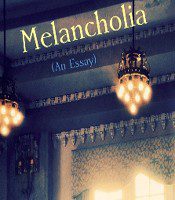Kristina Marie Darling’s wonderful new book of poems, Melancholia (An Essay)—her fourth—is more than a collection of abandoned footnotes and glossaries (poetic constructs she has been mastering since Night Songs), it is a history composed entirely of an ex-lover’s curios—a kind of “museum [that] specialize[s] in artifacts of / nineteenth century courtship rituals” (“Footnotes to a History of Melancholia”). Each curio magnifies distance—the distance between lover and beloved, for certain, but also between the poetic voice and the reader. In an interview in Stone Highway Review, Darling admits that the collection is partially autobiographical, that she “became fascinated by the ways that insignificant trinkets and worthless objects can signify mourning, humiliation, or profound joy” because she was in the midst of leaving someone important to her. The result is Melancholia (An Essay), a delicate glass jewelry box full to the brim with silver buttons, bits of ribbon, broken clasps and brass lockets.
Reading Melancholia (An Essay) requires that we do some work. The reader has no choice but to
create the main story line that has been buried beneath all the baubles, trinkets, and tchotchkes, which includes the piecing together of the lost lover himself. He may be lost, but Darling does include three untitled letter fragments that address him directly. Letters, surely, are an essential part of the lost lover narrative—maybe even more than the silent trinkets left behind—but they have a tendency to give the game away—to embarrassingly say too much. The love letter fragment, on the other hand, with all its immediate mystery has the exact opposite effect. We are lured on without being told very much at all. In the first of her letter fragments, for example, Darling writes,
Dearest—
you were like bits of broken glass
when the jewelry box shattered
night & the ocean’s coldest shore. (“untitled fragment” (i))
Here the lover is likened to the shattered glass of the jewelry box. In “untitled fragment” (ii), the lover is reduced to the memory of “the silver button/ on your black wool coat” but like the previous letter where the image of the jewelry box extends to include night and the ocean, the silver button extends to include a “a dream within a dream.” The lover’s materiality is never as direct as it may seem from the avalanche listing of things in the book because he is not actually present leaving the beloved to yearn and yearn:
Dearest—
(this letter will burn & burn). (untitled fragment” (iii))
 It is both an erasure—as I imagine the beloved burning these letters in her fireplace—and an extension into endless longing. With the lover missing, unnamed, in the shadows, lost to time, it falls to the reader to gather him up again.
It is both an erasure—as I imagine the beloved burning these letters in her fireplace—and an extension into endless longing. With the lover missing, unnamed, in the shadows, lost to time, it falls to the reader to gather him up again.
Darling uses fragmentation to force the reader to engage in the making of the text. Fragmentation, which may have reached its height in the poetry of the modern period, has a history in the Romantic period as well. Although Keats is not named in the collection, he was certainly a poet who knew something about melancholy, nightingales and fragments. The appearance of the Elgin marbles in England, for example, generated a large number of poems from writers of the time and brought fragments into the popular imagination. Some poets of dubious repute were writing fragments on purpose hoping to pass them off as ancient, classical texts, but others came to see that fragments and fragmentation could provide unique opportunities for expressing the radical subjectivism that came to be de rigueur among the Romantics. These poets had access to classic is through its ruins only—the bits and pieces of a bygone but also longed-for era. It is the same interesting marriage of longing and loss that Darling captures in these poems and without ever giving in to our desire to know the whole story. She manages the trick by being faithful to two dictums: “To select and omit, as a poet would” (“noctuary, definition”) and “To name, as a historian would” (“melancholia, definition”).




